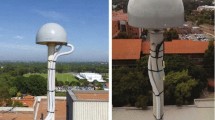Abstract
In the global positioning system (GPS), code division multiple access (CDMA) signals are used. Because of the known spectral characteristics of the CDMA signal, continuous wave (CW) interference has a predictable effect on the different pseudo random noise (PRN) spreading codes (unique to each satellite) depending on the Doppler frequency of the signal. The Doppler frequency for each signal is also predictable once the receiver position is known. As different satellite signals have different Doppler frequencies, the effect on the signal quality is also different. In this paper first the effect is studied analytically. The concept of an “exclusion zone” is defined and analyzed for each satellite. This exclusion zone, where that satellite should not be used due to interference degradation, is shown to be predictable for each satellite as a function of time. Using this prediction, the CW interference effect on the positioning quality of the receiver can be mitigated by ignoring the affected satellites within exclusion zones when performing position evaluation. The threshold beyond which a satellite should be excluded is then derived by studying the mutual effects of the geometry and the signal quality of that satellite on the positioning quality. Receiver autonomous integrity monitoring (RAIM) uses redundancy in measurements to perform an internal consistency check to see if all of the measurements are satisfactory. In this paper this technique is also used to mitigate the effect of CW interference on the positioning accuracy. Finally it is shown that the prediction of the exclusion zone for each satellite outperforms the RAIM algorithm in mitigation the effect of the interference when 5 satellites are visible.















Similar content being viewed by others
References
Abimoussa R, Landry RJ (2000) Anti-jamming solution to narrowband CDMA interference problem Canadian Conference on Electrical and Computer Engineering, Vol.2. Halifax, Canada, pp 1057–1062
Amoroso F (1993) Adaptive A/D converter i o suppress co-channel constant envelope interference in a mobile digital link. Telecommun Syst Model Anal Des Manage 2(1):109–119
Bastide F, Akos D, Macabiau C, Roturier B (2003) Automatic gain control (AGC) as an interference assessment tool. In: Proceedings of ION GPS 2003, Portland, OR, September 9–12, pp 2042–2053
Betz JW (2001) Effect of partial-band interference on receiver estimation of C/N0: theory in Proc. ION 2001. Institute of Navigation, Long Beach, pp 16–27
Betz JW (2000) Effect of narrowband interference on GPS code tracking accuracy. In: Proceedings of ION national technical meeting, Anaheim, CA, Jan. 2000, pp 16–27
Brown A, Reynolds D, Roberts D, Serie S (1999) Jammer and interference location system—design and initial test results, air force space battlelab. In: Proceedings of the ION GPS Nashville, Tennessee, pp 137–142
Brown A, Sturza M (1990) The effect of geometry on integrity monitoring performance. Institute of Navigation (ION) Annual Meeting, Atlantic City, pp 121–129
Dempster A (2006) How vulnerable is GPS? Position, no 20, Dec 2005/Jan 2006, pp 64–67
Fante RL, Vaccaro JJ (2000) Ensuring GPS availability in an interference environment. Position Location and Navigation Symposium IEEE San Diego, CA, USA, pp 37–40
Kaplan E (1996) Understanding GPS: principles and applications. Artech House, Norwood
Kaplan E, Hegarty C (2006) Understanding GPS: principles and applications, Artech House, Norwood
Kim N (2006) Interference effects on GPS receivers in weak signal environments. University of Calgary, Department of Geomatics Engineering Masters Thesis
Lijun W, Huichang Z, Gang X, Shuning Z (2005) AM-FM interference suppression for GPS receivers based on time-frequency analysis and synthesis IEEE international symposium on microwave Antenna. Propagat EMC Technol Wireless Commun MAPE 2005 2:1378–1381
Ndili A, Enge P (1998) GPS receiver autonomous interference detection. In: Position location and navigation symposium. IEEE, Palm Springs, 20–23 April 1998, pp 123–130
Parkinson BW, Spilker JJ Jr (1996a) Global positioning system: theory and applications, vol I. American Institute of Aeronautics and Astronautics, Inc, Reston
Parkinson BW, Axelrad P, Enge P (1996b) Global positioning system: theory and applications, vol II. AIAA Inc., Reston
Spilker J, Natali F (1996) Global positioning system: theory and applications. AIAA, REston
Tabatabaei Balaei A, Barnes J, Dempster AG (2006a) A novel approach in the detection and characterization of CW interference on the GPS signal using the receiver CN0 Estimation. Proceeding of IEEE/ION PLANS, San Diego, pp 1120–1126
Tabatabaei Balaei A, Dempster AG (2006b) A statistical inference technique for GPS interference detection. IEEE Trans Aerospace Elect Syst (submitted)
Yun Y, Kee C, Rife J, Luo M, Pullen S, Enge Per (2006) Detecting RFI through integrity monitoring at a DGPS reference station. J Navigat 59:403–422
Author information
Authors and Affiliations
Corresponding author
Additional information
An erratum to this article can be found at http://dx.doi.org/10.1007/s10291-008-0096-x
Rights and permissions
About this article
Cite this article
Balaei, A.T., Motella, B. & Dempster, A. A preventative approach to mitigating CW interference in GPS receivers. GPS Solut 12, 199–209 (2008). https://doi.org/10.1007/s10291-007-0082-8
Received:
Accepted:
Published:
Issue Date:
DOI: https://doi.org/10.1007/s10291-007-0082-8




